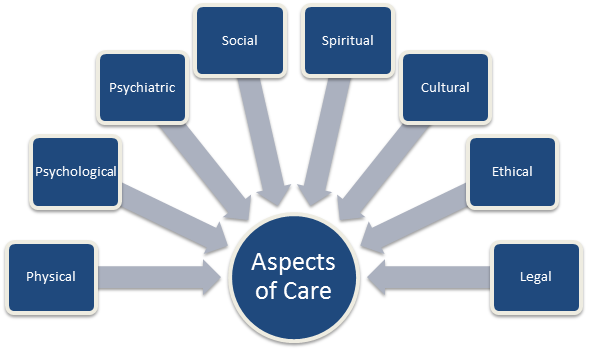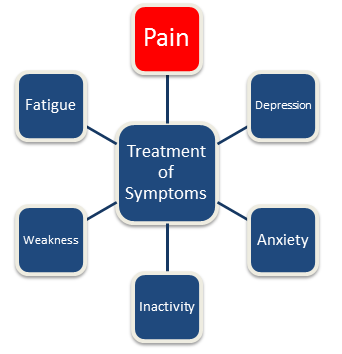Definition
End-of-life care, also known as Palliative care is defined by the World Health Organization as “multidisciplinary and holistic assessment and management of physical, psychosocial and spiritual symptoms, with the goal of alleviating suffering[1]” The American Cancer Society follows that idea by defining palliative care as “care for adults and children with serious illness that focuses on relieving suffering and improving quality of life for patients and their families, but is not intended to cure the disease itself.” Palliative care has transformed over the years from being indicated when aggressive treatment no longer was deemed appropriate, to today where palliative care “is given throughout the cancer experience, whenever the person is having symptoms that need to be controlled.[2]”
Role of Physical Therapist
As defined by the World Confederation for Physical Therapy; “Provide services to individuals and populations to develop, maintain and restore maximum movement and functional ability throughout the life-span… Physical Therapists are concerned with identifying and maximising quality of life and movement potential within the spheres of promotion, prevention, treatment/intervention, habilitation and rehabilitation.”[3] Therapists play an essential role in the interdisciplinary approach to palliative care by providing increased quality of life, function, and overall experience through physical and functional dimensions of care.[4] Essentially, a physical therapist aims to maintain optimal function, prevent atrophy and soft tissue deformities, influence pain control, foster independence and educate each patient with the resources they need to make all other goals attainable.[5]
In the literature, many authors write that a physical therapist’s role in palliative oncological care is as follows: gait training, therapeutic exercise, neuromuscular re-education, modalities, manual therapy and patient education.[5][6][7][8]
Palliative Care Models[9]
The patient and family is at the center of care, and addressing their desires is reflected in palliative physical therapy models.These models consider the extreme variations of the end-of-life course which may include periods of improvement, stabilization, and decline; also included within the models is the limited reimbursement structure of managed care. These models include:
Traditional Rehab
This model is most commonly utilized as Physical Therapy treatment in settings of Acute, sub acute, outpatient, and home health rehab. Treatments are scheduled daily to two or three times a week with the goal of improving patient function and limiting impairments. This model is utilized early in treating patients with palliative care needs when rehab potential is good despite having a poor long term prognosis. An example of this model would be for a patient undergoing surgical lobectomy of lung parenchyma to remove lung cancer and prevent metastasis. It would be beneficial for the patient to receive acute care level rehab to restore functional impairments followed by subacute or home health rehab[10].
Rehab Light
When symptoms have been managed and the person is feeling trail though somewhat better, they may express a desire to regain strength and mobility, even with the awareness that their condition is life limiting. A gentle rehabilitation program with weekly or biweekly visits can be applied, with instruction in limited but effectively targeted home exercise program and measured sitting or walking for endurance. This slower approach to treatment would be beneficial for patients experiencing secondary symptoms and impairments of fatigue, weakness, and atrophy from radiation therapy or chemotherapy in cancer patients. The frequency of treatment is commonly prescribed as once a week for four weeks or once every other week for eight weeks[11].
Case Management
In the instance that a patient has a complex condition with multiple comorbidities, is home bound, and does not have any medical needs or impairments that are out of the ability for the family or caregiver to safely provide for the patient, a case management model would fit well to monitor the patient and save costs. In this model, intermittent treatment sessions appointed monthly, bimonthly, or “as needed” are setup to reassess the functional status of the patient, continuing to educate the caregiver on proper transfers and exercise form, and updating any therapeutic exercise prescribed. These re-assessments are indicated and important knowing that care needs will arise because of the progressive nature of the illness.
Rehabilitation in Reverse
As impairments of strength and motor control change, it may threaten the patients ability to remain safely at home in the care of those they love. At various thresholds of decline, more support or assistance will be required to successfully navigate the environment and may require the use of a properly fitted cane, walker, or other assistive device. Physical assistance by caregivers is also likely to be required at some point as well, whether with ambulation, transfers or even moving in bed. Skilled physical therapy intervention and training can be provided throughout the course of decline, as it reflects the broad knowledge and teaching provided by therapists in more traditional settings, but in reverse order. This care can meet the patient’s desire to maintain maximal independence and mobility, and the family’s desire to successfully care for their loved one at home.
Skilled Maintenance
Skilled maintenance is similar to the case management model in which it occurs when patients have medical conditions that will make very little if no progress in health progression. However, in some complex situations it may occur that these patients will require skilled care performed by a Physical Therapist that would create an unsafe situation for the patient if administered by a caregiver. Situations with issues such as balance, tone, coordination or medical conditions such as cardiopulmonary and orthopaedic conditions would require the services and expertise of a Physical Therapist or other health care professional.
Supportive Care
Steps are taken to enhance patient comfort and improve quality of life and are essential to effective end-of-life care. Demonstration and teaching of appropriate techniques by the therapist to caregivers such as:
- Massage-provides temporary relief, long term management of edema, somato-sensory stimulus, and reduces muscle tension.
- Active, assistive, or passive range of motion-eases discomfort of inactivity and prevents contractures.
- Guided imagery-provides a common pleasant experience when combined with range of motion activities
- Vestibular stimulation-a gentle rocking motion and provide comfort.
- Conversation-provides sharing of information, meaning, and understanding which can support the end-of-life process.
Interventions
Physical therapy in palliative care is often directed toward controlling symptoms and compensating for lost function.[12] Pain, symptoms arising from skeletal metastases, impaired muscle strength and endurance, neurological symptoms, pulmonary secretions, dyspnoea, lymphedema, and venous thrombosis are common symptoms that are treated by physical therapists.[13]
Physical therapists should seek to maintain strength, make environmental modifications, furnish necessary assistive equipment, teach energy management techniques, provide family education; achieve safety, independence, meaning, and quality of life, despite the physical and mental decline which is expected.[14]
Physical Therapy Pain Management
Cancer pain can be classified as one of the three types; symptom-based, syndrome-based, or mechanism-based.[15] According to the literature, classification based upon mechanism not only addresses the underlying pathology but also provides us with an understanding behind patient’s symptoms and treatment responses.[16] The evolution of cancer pain classification has been the direct result of the need to adequately address the underlying source of the patient’s cancer pain. This void in the literature shifted the attention and focus to mechanism-based classification and the non-pharmacological approach to symptom control.[15] Studies conducted by different authors found that using qualitative methodology of expect physical therapists who used this form of pain classification during the evaluation of patients pain were more likely to improve the quality of life and decrease the amount of pain experienced after treatment.[15][16][17][18][19] The five categorized mechanisms and their descriptions are defined below in addition to the recommended intervention strategies to be employed by a physical therapist.
Defined as increased sensitivity of a higher order neuron within the central nervous system, that causes constant pain in the absence of a peripheral nociceptive stimulus.[15] Defined as neuropathies to the brachial plexus and cranium, as well as chemotherapy-induced, post-herpetic and surgical neuropathy in addition to post-radiation plexopathies.[15] Defined as pain secondary to non-use, deconditioning and/or improper posture and movements resulting from symptoms of cancer pain.[15] Defined as the over activation or under activation of the sympathetic nervous system.This pain could be described as “burning” and “throbbing”, and associated with allodynia, hyperpathia, and hypoalgesia.[15] Defined as cancer-related or treatment-related pain that can be characterized as anxiety, depression or guilt. Patients might become preoccupied by pain and have low self-confidence while becoming highly stressed with social/environmental factors.[15] A study by Dahlin & Heiwe that interviewed patients who participated in physical therapy within palliative cancer care, found that they experienced the feeling of motivation and encouragement, relief and well-being, hope for a time-limited improvement in a specific area, independence, and security. Patients also expressed that their own knowledge was insufficient of what physical therapy could do for them and it was hard for them to know what they could ask for during their sessions. In some cases physical therapy has not been offered to them at all, or patients felt they did not have enough treatment.1. Central Sensitization
Recommended Interventions[16]
2. Peripheral Sensitization/ Neuropathic
Recommended Interventions[16]
3. Nociceptive Mechanism
Recommended Interventions[16]
4. Sympathetic-Maintained/ -Dependent Pain Mechanism
Recommended Interventions [16]
5. Cognitive-Affective Mechanism
Recommended Interventions[16]
Patient Experience[20]
| Motivation | Encouraged | Relief & Well Being |
| Security | Hope | Independence |
Case Reports/ Case Studies
Resources
References
- ↑ WHO Definition of Palliative Care. Geneva: World Health Organization; c2003. Available from: ↑ ↑ World Confederation for Physical Therapy. Policy Statement: Description of Physical Therapy What is Physical Therapy? London, UK. Available from ↑ Eagan KA, Abbott P. Interdisciplinary team training- preparing new employees for the specialty of hospice and palliative care. J Hosp Palliat Nurse. 2002; 4:161-171.
- ↑ 5.05.1 Kumar SP, Jim A. Physical Therapy in Palliative Care: From Symptom Control to Quality of Life: A Critical Review. Indian J Palliative Care. 2010; 16(3): 138-146.
- ↑ Flomenhoft D. Understanding and helping people who have cancer: A special communication. Phys Ther. 1984; 64:1232-1234.
- ↑ Rashleigh LS. Physiotherapy in palliative oncology. Aust J Physiother. 1996; 42:307-312.
- ↑ Santiago-Palma J, Payne R. Palliative care and rehabilitation. Cancer. 2001; 92:1049-1052.
- ↑ Briggs R. Clinical decision making for physical therapists in patient-centered end-of-life care. Topics in Geriatric Rehabilitation 2011; 27(1): 10-17.
- ↑ Briggs, R. Models for Physical Therapy Practice in Palliative Care. Rehabilitation Oncology. 2000: 18(2): 18-21.
- ↑ Briggs, R. Models for Physical Therapy Practice in Palliative Care. Rehabilitation Oncology. 2000: 18(2): 18-21.
- ↑ Carter H, MacLeod R, Brander P, McPherson K. Living with a terminal illness; patients’ priorities. J Adv Nurs 2004; 45(6): 611-620.
- ↑ Donnelly S, Walsh D. The symptoms of advanced cancer. Semin Oncol 1995; 22(2 suppl 3): 67-72
- ↑ Pizzi MA, Briggs R. Occupational and physical therapy in hospice: the facilitation of meaning, quality of life, and well-being. Topics in Geriatric Rehabilitation 2004; 20(2): 120-130.
- ↑ 15.015.115.215.315.415.515.615.7 Kumar SP. Cancer Pain: A Critical Review of Mechanism-based Classification and Physical Therapy Management in Palliative Care. Indian J Palliat Care. 2011; 17(2): 116-126.
- ↑ 16.016.116.216.316.416.516.6 Kumar SP, Saha S. Mechanism-based Classification of Pain for Physical Therapy in Palliative Care: A Clinical Commentary. Indian J Palliat Care. 2011; 17(1): 80-86.
- ↑ Smart K, Doody C. Mechanism-based clinical reasoning of pain by experienced musculoskeletal physiotherapists. Physiotherapy. 2006; 92: 171-178.
- ↑ Smart K, Doody C. The clinical reasoning of pain by experienced musculoskeletal physiotherapists. Man Ther. 2007; 12:40-49.
- ↑ Levin M. Changing the face of pain management- mechanism-based treatment most likely to succeed. Postgrad Med. 2004; 116:45-48.
- ↑ Dahlin Y, Heiwe S. Patients’ experiences of physical therapy within palliative cancer care. Journal of Palliative Care 2009; 25(1): 12-20.
- ↑ [[Ferrell BR, Temel JS, Temin S, Alesi ER, Balboni TA, Basch EM, Firn JI, Paice JA, Peppercorn JM, Phillips T, Stovall EL, Zimmermann C, Smith TJ. Integration of palliative care into standard oncology care: American Society of Clinical Oncology clinical practice guideline update. J Clin Oncol. 2017 Jan;35(1):96-112.
- ↑ Ferrell BR, Temel JS, Temin S, Alesi ER, Balboni TA, Basch EM, Firn JI, Paice JA, Peppercorn JM, Phillips T, Stovall EL, Zimmermann C, Smith TJ. Integration of palliative care into standard oncology care: American Society of Clinical Oncology clinical practice guideline update. J Clin Oncol. 2017 Jan;35(1):96-112.






